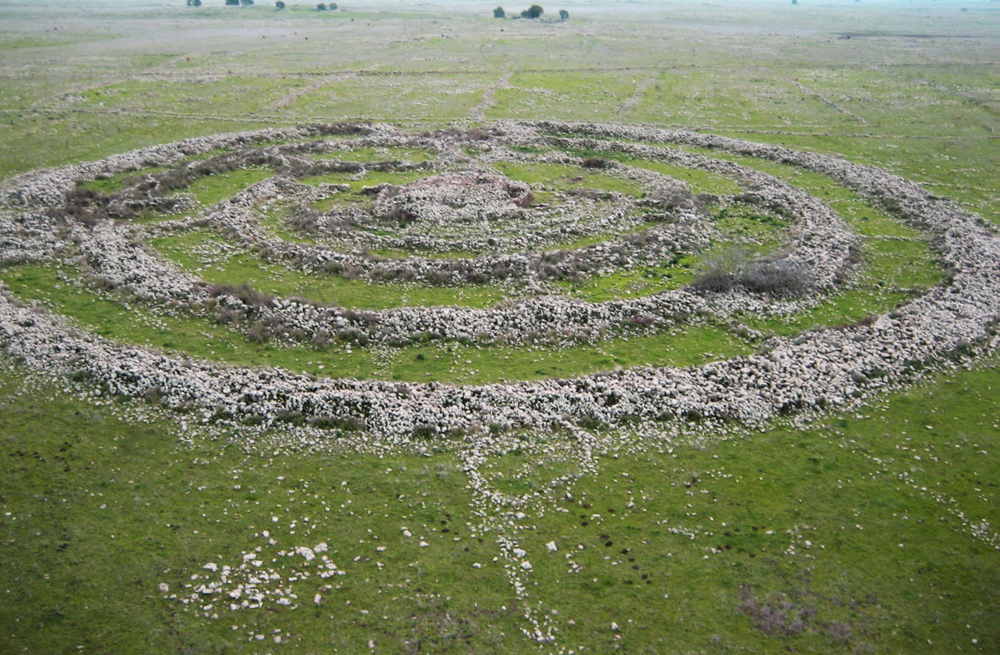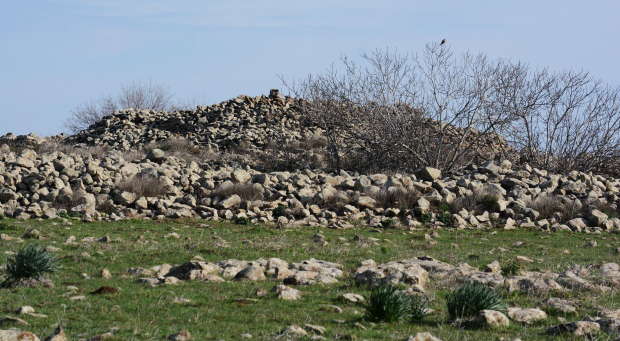


An online article from CBCNews/Thomson Reuters - Stonehenge-like structure 'Wheel of Giants' a mystery in the Middle East - reports on the significant stone monument which has largely been ignored, despite being thought to be contemporaneous with Stonehenge.

Image: wikipedia/commons
The prehistoric stone monument is located in a bare expanse of field on the Golan Heights, close to the eastern coast of the Sea of Galilee. After Israel captured the territory from Syria in 1967, archaeologists studying an aerial survey spotted a pattern of stone circles not easily visible from the ground. Subsequent excavations revealed it was one of the oldest and largest structures in the region.

Image: wikipedia/commons
Known as 'Rujm el-Hiri' in Arabic, meaning the 'stone heap of the wild cat', the complex has five concentric circles, the largest more than 150 metres wide, with a large burial chamber in the middle. Its Hebrew name 'Gilgal Refaim', or 'wheel of giants', refers to an ancient race of giants mentioned in the Bible.
Archaeologists such as Uri Berger of the Israel Antiquities Authority, believe it is up to 5,000 years old, hence the link to Stonehenge, but the Golan structure is made of piles of thousands of small basalt rocks. He admits that no one knows who built the site; possibly a nomadic civilisation that settled the area, although it would have required a tremendous support network that itinerants might not have had.
The labyrinth of crumbling stone walls is now overgrown with weeds, but from the top of the five-meter-high burial mound it is possible to make out a circular pattern. As to the purpose, there could be an astrological significance. On the shortest and longest days of the year - the June and December solstices - the sunrise lines up with openings in the rocks.
The discovery of shards of pottery and flint tools in various excavations has helped date the site, with construction beginning as early as 3,500 BC. Other parts may have been added over the next two thousand years.
Visit the Rock Art Archive of the Middle East:
by Bradshaw Foundation
Monday 04 December 2023
by Bradshaw Foundation
Friday 30 June 2023
by Bradshaw Foundation
Thursday 06 April 2023
by Bradshaw Foundation
Thursday 24 November 2022
by Bradshaw Foundation
Tuesday 27 September 2022
by Bradshaw Foundation
Thursday 08 September 2022
by Bradshaw Foundation
Tuesday 19 July 2022
by Bradshaw Foundation
Monday 06 June 2022
by Bradshaw Foundation
Friday 11 March 2022
by Bradshaw Foundation
Wednesday 02 March 2022
by Bradshaw Foundation
Thursday 26 August 2021
by Bradshaw Foundation
Monday 16 August 2021
by Bradshaw Foundation
Tuesday 06 July 2021
by Bradshaw Foundation
Thursday 06 May 2021
by Bradshaw Foundation
Thursday 06 May 2021
by Bradshaw Foundation
Tuesday 16 March 2021
by Bradshaw Foundation
Monday 04 December 2023
by Bradshaw Foundation
Friday 30 June 2023
by Bradshaw Foundation
Thursday 06 April 2023
by Bradshaw Foundation
Thursday 24 November 2022
by Bradshaw Foundation
Tuesday 27 September 2022
by Bradshaw Foundation
Thursday 08 September 2022
by Bradshaw Foundation
Tuesday 19 July 2022
by Bradshaw Foundation
Monday 06 June 2022
by Bradshaw Foundation
Friday 11 March 2022
by Bradshaw Foundation
Wednesday 02 March 2022
by Bradshaw Foundation
Thursday 26 August 2021
by Bradshaw Foundation
Monday 16 August 2021
by Bradshaw Foundation
Tuesday 06 July 2021
by Bradshaw Foundation
Thursday 06 May 2021
by Bradshaw Foundation
Thursday 06 May 2021
by Bradshaw Foundation
Tuesday 16 March 2021
Friend of the Foundation











